Historic Site
Former
Temple Precinct of Hakusan Heisenji: A vast Medieval
religious urban center built with stone. Stone-paved roads and stone
fences of the Warring States period emerged.

An excavated Medieval stone-paved road A Medieval stone-paved road excavated in a mountain area of the 3,600 residential remains of the southern valley. Approximately 230 m were excavated of the road, 2.1 ∼ 3 m in width and packed with river cobbles as paving. Entrances to the residences seen on both sides (arrows) are found at evenly spaced intervals. At present, it is the largest excavated Medieval stone-paved road nationwide. 
Hakusan seen from
the skies above Heisenji |

Schematic map of
Heizenji 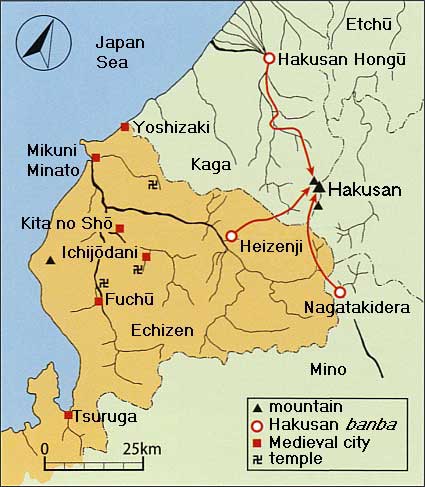
The "three banba," bases for the Hakusan cult |
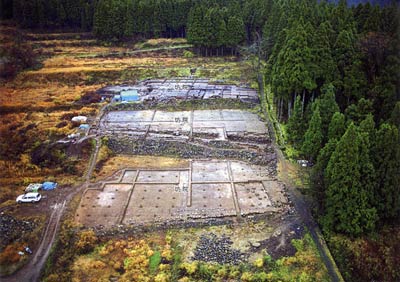
Excavation
proceeding at the remains of 3,600 residences in the southern valley |

Heisenji Jizōin
hypothetical reconstruction (original drawing: Yoshioka Yasuhide) |
(principal artifacts, Former Temple Precinct of Hakusan Heisenji)
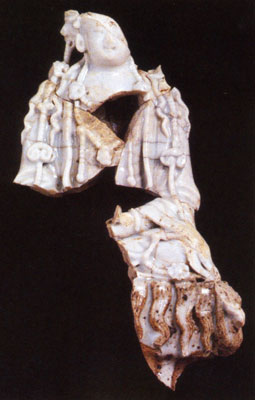
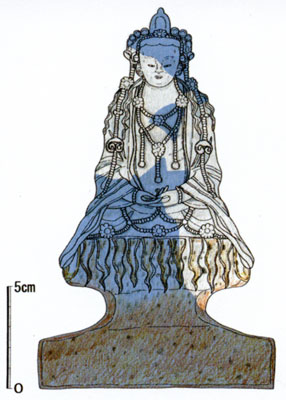
Light blue
porcelain Bodhisattva
Early fourtheenth
century.
Surviving height: 13
cm (reconstructed as 20 cm); width: 10 cm.
Produced at the
Jingdezhen kiln in Yuan Dynasty China. Thought to be portrayed as
sitting on a boulder draped in cloth, with the hands resting on the
knees in a mudra of meditation. Accessories depicted as jewels and
flowers adorn the body, and the sleeve of the garment drapes down to
the seat. As examples of Yuan period light blue porcelain
Bodhisattvas are virtually unknown in Japan, this is an important
item for considering the trade, circulation of goods, and culture of
the time. In the reconstructed drawing, the white portions are those
actually recovered.
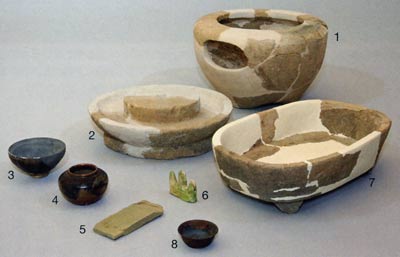
Buddhist
paraphernalia and other items of choice of priests
Warring States
period, fifteenth ∼ sixteenth centuries.
1. Portable stone brazier (height: 23.8 cm; diameter: 39.5 cm). 2. Tea mortar. 3. Seto-Mino ware tenmoku-glazed tea bowl. 4. Seto-Mino ware tea caddy. 5. Inkstone. 6. Huanan sancai brush rest. 7. Stone basin. 8. Copper rokki bowl.
As Buddhist paraphernalia utilized by the priests, copper dishes (rokki) for placing on a Buddhist altar and prayer beads were recovered. As utensils favored by the priests, there were stationary goods (inkstones, ink, brushes, brush rests) and tea ceremony utensils (tea mortars, tea urns, tea caddies, tenmoku-glazed tea bowls, braziers), basins for flower arranging and Chinese high quality ceramics for decorating a sitting room. In addition, fragments of armor and projectile points were recovered, probably used by warrior monks.

Utensils of daily
life
Warring States
period, fifteenth ∼ sixteenth centuries.
1. Echizen ware jar (height: 46.9 cm; diameter: 38.1 cm). 2. Echizen ware mortar bowl. 3. Seto-Mino ware grating dish. 4. Ladle. 5. Knife. 6. Cutting board. 7. Celadon dish. 8. Seto-Mino ware bowl. 9. Celadon bowl. 10. Qinghua ware bowl 11. Celadon dish. 12. Porcelain dish. 13. Celadon lobed dish 14. Qinghua ware dish 15. Seto-Mino ware dish. 16. Porcelain small bowl. 17. Chopsticks and chopstick rest. 18. Stone foot warmer. 19. Unglazed earthenware sake cups.
The bulk of the items recovered from the remains of residences are articles of daily life. Echizen ware, from the ancient province of Echizen where Heizenji was located, was used for storage jars and cooking utensils such as mortar bowls, and cooking was evidently done with the aid of cutting boards, knives, and wooden ladles. For tableware, stoneware of Chinese manufacture was utilized more than domestic Seto-Mino ware. Also, in order to overcome the severe winters, stone foot warmers and ceramic charcoal braziers were used.
Former Temple Precinct of Hakusan Heisenji, Katsuyama City, Fukui Prefecture
A temple base for the Hakusan cult
The former temple precinct of Hakusan Heisenji is a medieval mountain temple, located at the entrance on the Echizen (Fukui prefecture) side to a path for ascent and worship of the sacred mountain Hakusan, and is generally known by the name of Heisenji. Today the entire area of the former precinct of Heisenji, roughly 200 ha, is designated a Historic Site (designated in 1935, and extended to all of the former precinct in 1997), and excavation and preparation as a Historic Site are being conducted by the Katsuyama municipal Board of Education.
According to Hakusan no ki which has been passed down in Ishikawa prefecture, the three ancient provinces of Echizen, Kaga (Ishikawa) and Mino (Gifu) all had starting points for paths, leading up to the mountain peak, that were points of departure for ascetic training (banba); these bases for the Hakusan cult were called the "three banba," indicating Heisenji of Echizen, Hakusan Hongū of Kaga (in the city of Hakusan), and Nagatakidera of Gifu (in Gujō). Among these Heisenji is closely linked with the Echizen priest Taichō who founded the cult in the eighth century, and is recognized as the core temple of the Hakusan cult.
From Heisenji to Hakusan shrine
At the peak of its prosperity, from the Muromachi to the Warring States periods, it is related that Heisenji could boast a strength rivaling the major warlords, consisting of: 48 shrines and 36 temples standing within its precinct, along with an urban complex of sanctuaries, pagodas, and living quarters for priests or shrine personnel; a domain yielding revenues of 90,000 koku of rice (1 koku = approx. 180 l, or 5.1 bushels), or 90,000 kan of copper coin (1 kan = 1,000 coins called mon); 8,000 warrior monks. But in 1574, the Echizen uprising of followers of the Honganji sect of Jōdo Shinshū Buddhism occurred, and Heisenji was attacked and burned as an enemy force, being completely destroyed in the conflagration. After rebuilding, the precinct was reduced to one tenth of its former scale, and with the Meiji program of separation of Shinto and Buddhism the temple name of Heisenji was abolished, and became Hakusan Jinja (shrine).
A Medieval religious city comes to light
In the investigations to ascertain the extent of the site, conducted from 1989 by the Katsuyama municipal Board of Education, beneath the forest and paddy several hundred meters distant from the precinct of Hakusan shrine, stone-paved roads and stone fences of the Medieval period were excavated in well preserved condition. These features are thought to belong to the Warring States period, from the second half of the fifteenth to the second have of the sixteenth centuries.
As the investigation proceeded, the Medieval landscape of Heisenji as a large urban religious center came floating into view. The former Heisenji precinct, located on a ridge extending westward from the 777.5 m elevation mountain Mitsugashira, and was ascertained to have spread over a wide area 1.2 km east-west by 1 km north-south, ranging from 240 to 400 m in elevation.
The present day Hakusan shrine precinct is the area where the central cloister of Heisenji had been, which is understood to have been a syncretic mixture of Shinto and Buddhism, with Shinto style buildings, such as an inner shrine (honden) and worshipper's hall (haiden) 33 spans long, standing alongside Buddhist style buildings, such as a large pagoda and lecture hall.
6,000 residences on the northern and southern valleys
Large clusters of residential complexes collectively known as the Rokusenbō (6,000 residences) stood on both sides of the central cloister, located on northern and southern valleys. At the 3,600 residences of the southern valley in particular, stone-paved roads laid out horizontally and vertically on a grid, a planned arrangement of numerous residences, and stone fences lined up in the manner of stairs have been excavated.
Each residence was made by leveling the gradual slope, with a scale averaging about 1,000 sq m. The grounds were enclosed by earthen walls, within which stood several buildings. From these residences articles of daily living, such as Chinese and domestic glazed stoneware, writing implements and Buddhist paraphernalia, have been excavated in large quantities, showing the style of living of Heizenji priests at the height of its prosperity.
Also, as the oldest material from the former precinct, Sue ware of the first part of the ninth century was recovered. Artifacts from that time on have been ascertained for the 1,000 year span to the Edo period, but quite understandably those of the fifteenth to sixteenth centuries are most numerous, totaling several hundred thousands of items including fragments.
Heisenji of the Warring States period contained a population of around 8,000, and is understood to have been the economic and cultural center of this region. In recent years the existence of this kind of Medieval religious urban center has begun to be recognized at locations throughout the country. In the manner of Negoroji in Wakayama and Ishiyama Honganji in Osaka, the results of the excavations at Heisenji are of extreme importance for understanding the conditions of a temple controlling an entire region in the Medieval period. (Hōchin Shin'ichirō, Matsumura Hideyuki)
